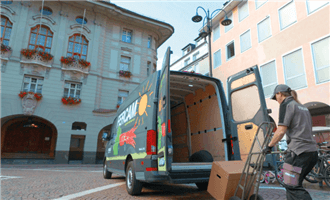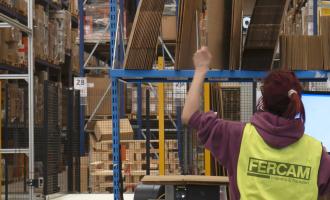
29 July 2020 - by: Eleonora Castagna
E-commerce and home delivery: how will the lessons learned during the lockdown translate to the future?
Many people had never ordered online before being confined in quarantine by Covid-19, but this unusual situation led to a spike in e-commerce purchases. In the future, the focus will be on omnichannel systems and experiencing the dynamics of glocalization. So how can you manage the image of your brand with the end customer when the only contact is virtual?

According to projections by the B2C eCommerce Observatory, promoted by the Politecnico di Milano, in 2020 online sales will report an overall peak of +26% compared to last year, reaching €22.7 billion. It is the highest increase ever, for a purchasing method that is already growing exponentially.
Overburdened with unexpected requests, courier service providers have not always been able to manage the new volume of deliveries, sometimes risking drops in the quality of their solutions. Part of the demand has therefore spilled over to companies that usually handle larger packages, using different organization systems within their transit centers and means of transport that are not always ideal for a high number of daily deliveries to city centers. Centers that managed a limited number of deliveries for medium-large packages found themselves having to deliver up to four times the number of light packages on a daily basis, by appointment, perhaps using vehicles with tail lifts that had to be lowered at each delivery.
A challenge met with a spirit of positive initiative, reacting promptly to the rapid change in the market, which also represented an opportunity to counterbalance the falling demand for some product sectors during the emergency phase. But a challenge nonetheless, which has led to operating outside one's comfort zone with impromptu solutions.
Although, once the health crisis has been effectively overcome, people will want to return to in store shopping and to see products first hand, there is no doubt that a mechanism has been triggered that is not going to go away. For example, there is a lot of talk these days about new points for the collection and return of goods with dedicated lockers, managed privately or with the support of municipalities and public institutions. From this perspective, therefore, a new normality is also being envisaged, which leaves the choice regarding the most suitable purchasing method to the individual consumers' needs.
Many logistics and transport companies will therefore find themselves evaluating whether and how to integrate distribution methods expressly dedicated to the e-commerce sector, remodeling processes and standard fleets, reorganizing or automating warehouses and in general rethinking their business dynamics.
The watchword for the future is undoubtedly flexibility, with the aim of overcoming intrinsic limits of established purchasing methods. Physical channels and e-commerce can no longer be perceived by sellers as separated from each other but must be designed thinking of mutual interdependence. How can we encourage the engagement of users and increase the number of interactions? How can we translate the buyer's physical experience or emotional sales into the digital world? How can we ensure that the quality of the products is tangible even remotely? How can we offer purchase assistance and advice? It will be imperative for every organization that deals with the world of online sales, as well as for those dedicated to improving current solutions, to seek answers to these questions, with the main objective of understanding and meeting the evolution of consumer needs. Digital is not just an alternative method: it is the strategic key for business development, here and now.
Marco Gentile, Head of the Business Unit, says: "Our specialized teams deal with transport, delivery to the floor, assembly, installation and potential functional testsof electronic equipment. Not only that, we manage the collection and disposal of packaging, where required we take second-hand goods and, through our professional and tested distribution network, we guarantee the collection and disposal of WEEE waste in compliance with current European regulations. We have also implemented additional safety measures: our staff strictly wear personal protective equipment during the entire course of operations and work with the utmost regard for the well-being of all those they come in contact with. We ask customers to not be present during the installation phases and to ventilate the premises, as well as to report the compliance of all the operators involved with the regulations on the delivery form. For some clients we have created custom projects, customizing vehicles and uniforms with ad hoc branding. The dedicated team specializes on the product and works exclusively for that particular customer, who is therefore represented with great professionalism in all final deliveries”.
Would you like more information on our Home Delivery service?
Contact us
The explosion of e-commerce in the period of Covid-19 is an opportunity and a challenge for transport companies
As is known, the boom occurred during the lockdown, a period in which e-commerce went from being a secondary channel to playing a strategic role in the generation of consumption. People still reluctant to buy online had a new opportunity to overcome their doubts during the quarantine. Having experience the convenience, speed and even the security of making payments online, many have joined the already substantial mass that regularly exploit this channel. The growth has been explosive and has significantly impacted the supply-demand balance in the distribution sector. Small and medium-sized enterprises have also reacted quickly, organizing digital showcases and home delivery systems, so that countries that are still one step behind in terms of digital innovation compared to the international average have seen the gap narrow in a very short time.Overburdened with unexpected requests, courier service providers have not always been able to manage the new volume of deliveries, sometimes risking drops in the quality of their solutions. Part of the demand has therefore spilled over to companies that usually handle larger packages, using different organization systems within their transit centers and means of transport that are not always ideal for a high number of daily deliveries to city centers. Centers that managed a limited number of deliveries for medium-large packages found themselves having to deliver up to four times the number of light packages on a daily basis, by appointment, perhaps using vehicles with tail lifts that had to be lowered at each delivery.
A challenge met with a spirit of positive initiative, reacting promptly to the rapid change in the market, which also represented an opportunity to counterbalance the falling demand for some product sectors during the emergency phase. But a challenge nonetheless, which has led to operating outside one's comfort zone with impromptu solutions.
Although, once the health crisis has been effectively overcome, people will want to return to in store shopping and to see products first hand, there is no doubt that a mechanism has been triggered that is not going to go away. For example, there is a lot of talk these days about new points for the collection and return of goods with dedicated lockers, managed privately or with the support of municipalities and public institutions. From this perspective, therefore, a new normality is also being envisaged, which leaves the choice regarding the most suitable purchasing method to the individual consumers' needs.
Many logistics and transport companies will therefore find themselves evaluating whether and how to integrate distribution methods expressly dedicated to the e-commerce sector, remodeling processes and standard fleets, reorganizing or automating warehouses and in general rethinking their business dynamics.
Omnichannel, online-offline integration, glocal: the future of sales channels is today
With the progressive change in consumption habits, we are getting closer and closer to the omnichannel paradigm. On average, half of digital buyers make their purchases from smartphones, thanks also to systems designed from the outset for use on mobile, dedicated applications and personalized experience. Home delivery will not always be the preferred solution, integrated online and offline methodsare widely used with phenomena such as click & collect, or online purchase with in-store pickup. Sometimes you want to touch the product in the store firsthand, but then in the absence of the desired goods or for simple convenience, you choose to purchase online with home delivery. Or you can buy online but make any returns in the store. These are typical phenomena which are called proximity e-commerceand a manifestation of the trend towards 'glocalisation', or the synergy between local solutions and international services thanks to the use of information technologies. Omnichannel essentially means knowing how to offer customers a consistent, seamless experience, regardless of the access point.The watchword for the future is undoubtedly flexibility, with the aim of overcoming intrinsic limits of established purchasing methods. Physical channels and e-commerce can no longer be perceived by sellers as separated from each other but must be designed thinking of mutual interdependence. How can we encourage the engagement of users and increase the number of interactions? How can we translate the buyer's physical experience or emotional sales into the digital world? How can we ensure that the quality of the products is tangible even remotely? How can we offer purchase assistance and advice? It will be imperative for every organization that deals with the world of online sales, as well as for those dedicated to improving current solutions, to seek answers to these questions, with the main objective of understanding and meeting the evolution of consumer needs. Digital is not just an alternative method: it is the strategic key for business development, here and now.
Home deliveries with added value, or how to manage your image with the end customer
Among the concerns of companies that interact digitally with their customers is often the delicate moment of the final interaction, the delivery of the product. It is crucial to choose a courier that knows how to devote the same attention to the home delivery phase that would be paid to your customer in the store. They trust that the courier will take care when interacting with recipients, that they will not neglect important relational considerations and maintain a high quality of service, so as not to undermine the image and reputation of their brand. The Home Delivery unit of FERCAM aims address these issues in an exemplary way, with a complete solution with high added value.Marco Gentile, Head of the Business Unit, says: "Our specialized teams deal with transport, delivery to the floor, assembly, installation and potential functional testsof electronic equipment. Not only that, we manage the collection and disposal of packaging, where required we take second-hand goods and, through our professional and tested distribution network, we guarantee the collection and disposal of WEEE waste in compliance with current European regulations. We have also implemented additional safety measures: our staff strictly wear personal protective equipment during the entire course of operations and work with the utmost regard for the well-being of all those they come in contact with. We ask customers to not be present during the installation phases and to ventilate the premises, as well as to report the compliance of all the operators involved with the regulations on the delivery form. For some clients we have created custom projects, customizing vehicles and uniforms with ad hoc branding. The dedicated team specializes on the product and works exclusively for that particular customer, who is therefore represented with great professionalism in all final deliveries”.
Would you like more information on our Home Delivery service?
Contact us
Share


 Language
Language

























